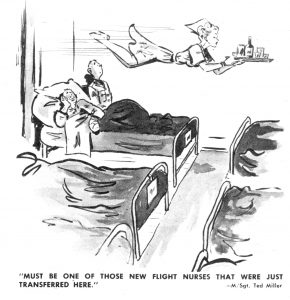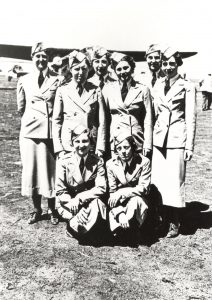In Memoriam
World War II Army Flight Nurses
Jenevieve (Jenny) Boyle Silk, who died in June 2017, was the last living of the 25 World War II US Army flight nurses whom I interviewed in 1986 for what became Beyond the Call of Duty: Army Flight Nursing in World War II. I clearly remember each of my interviews with these remarkable women and still can picture them and hear their voices when I think of them.
Twenty of these interviews are now digitized and available as audio recordings on the Imperial War Museum website. Access the interviews here:
My short remembrances are in the order in which I interviewed these former flight nurses.
Hilda Halverson Chamberlain (1914–1993)
826 MAES, Pacific
Hilda Chamberlain née HALVERSON (Henrotin Hospital School of Nursing, Chicago, 1937) worked as a visiting nurse, then moved to southern California to work as an industrial nurse with Douglas Aircraft. After the attack on Pearl Harbor, when she was told that she was frozen in her civilian job and could not join the military, she joined anyway in 1942. Asked what made her want to join, Hilda replied: “Well, it made me mad that somebody could tell me that I couldn’t go do something else, although being an industrial nurse was a very lucrative job and paid well – nice benefits. But it made me mad, and I was still thinking about Pearl Harbor, and I got madder and madder.” So Hilda worked all night, then drove to Santa Ana to take her physical for the military, which she passed.
After entering the Army in 1942, Hilda was sent to Hammer Field, CA as her first duty station, followed by assignment to March Field, also in CA. Hilda always had liked to fly, so she applied for flight nurse training, was accepted when at March Field, and traveled to Bowman Field, KY for the class that graduated on 26 May 1944. Her training, Hilda said, was “excellent … we were ready for anything, physically and mentally.” Hilda initially flew domestic air evacuation missions in the US before her squadron, the 826 MAES, was assigned to duty in the Pacific with home base at Hickam Field, HI near Honolulu.
Eventually Hilda and the other nurses in her flight of six were sent to Saipan to air evac patients from the different islands – Okinawa, Guam, the Philippines – back to Honolulu. Hilda remembered irregular hours and long flights up to sixteen hours on which, if no patients were on board, she learned to sleep “real good” on the floor of the plane. Her mind, however, was not always at rest, for, as she explained, “you’re geared, as a nurse you’re always thinking, what can you do for the next person.”
On one of her memorable missions from Leyte in the Philippines, the Japanese had just made a raid on the airfield. Hilda picks up the story: “It had been raining as it often does in the tropics, and we got our patients off as fast as we could, the sergeant and myself. And then I heard somebody say, ‘Where’s the nurse? Is the nurse all right?’ And I was down in the mud trying to cover this young soldier’s head wound. … I didn’t want it to get muddy.” So she sprawled on top of him to keep him safe. “Here I am, all muddy,” she said, “and they teased me. They said, ‘Oh, we’d have never found you!’”
Asked what helped her the most to get through her duties as a flight nurse during the war, Hilda replied, “I think my training – nurses training and at Bowman. And I got what I wanted, you know. I would’ve done anything, ’cause that’s what I wanted to do.”
To listen to my interview with Hilda Chamberlain, click on the link:
https://www.iwm.org.uk/collections/item/object/80011346
Interviewed 21 Jun 1986, Spokane, WA
Learn more about my interview with Hilda on the Blog for 20 Nov 2016.
To be continued



